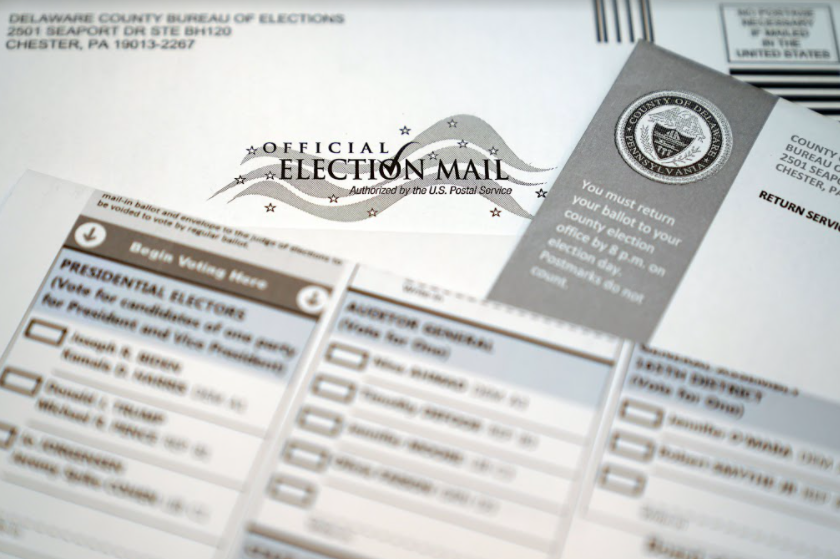Michelle Jiang ‘24 | Sophia Hu ‘24 | Anjali Ramakrishnan ‘24
After the recent election, the EA community has discussed the concerns about potential voter fraud and mail-in ballots in classrooms, hallways, and more. Voter fraud is often speculated about when the losing party believes they lost because of mishaps in the election process. This can be through illegal interference in the election itself or in the process of counting ballots. Suspicion of rigged elections has been brought up in past presidential elections, although very little evidence has been supportive of these claims. In the 2004 presidential election, there were speculations about the win of George W. Bush, which claimed that he did not honestly defeat his competitor John Kerry. Despite the controversy, Kerry conceded because the rumors lacked serious evidence.

Photo courtesy of Ashley Kennedy
This year, rumors that the election was fraudulent have arisen because of the increased number of mail-in ballots, an option included in the electoral process to address the current pandemic. As a result, some believe that President-Elect Biden did not fairly win the election. In almost all the states in which votes were recounted, there has been no evidence of voter fraud.
Voting by mail has been deemed effective by election officials because the convenience encourages more people to voice their opinions. Additionally, concerns around spreading COVID-19 at polling stations prompted more people to vote by mail this election cycle. David Mercante, AP US Government teacher, states, “It is always harder to get people to vote in the United States for whatever reason,” and that “voting by mail makes it easier for people to vote, and because it’s easier, more people would actually vote.” Vince Vento ‘21, leader of the Young Democrats Club, explains that “some people do not have the ability to vote in person, whether [if it’s] due to family or professional reasons.” Alexander Jimenez, faculty advisor for the Young Democrats, did an “in-person mail-in ballot, similar to a drop off. This was also my first time voting by mail.”
Evidence and results from the 2020 election suggest that Democrats tend to prefer the mail-in option more than Republicans. Jon Shanahan ‘21, President of the Young Republicans, explains, “[mail-in voting] is more favored [towards Democrats] since Trump supporters believed it to be fraudulent, and therefore causing them to not use mail-in ballots.” Vento comments, saying that “I think it’s ridiculous that some people think it’s unfair to vote by mail because it merely allows more people to vote, which is an inherently American act. If someone were to be scared of voting by mail because it gives more people the chance to vote, it doesn’t shine positively on their character.” Mercante adds, “if we assume that the claims of how some Democrats have a lack of access to in-person voting are true, then mail-in ballots should be seen as a good thing. No leader would want to win an election just because people who could vote weren’t able to.” Gavin Schmidt ‘24, elaborates on the possibility of fraud when voting by mail, saying, “paper is not always as safe as in person voting ballot machines.” Vento, however, has seen “no indication thus far [for fraud in voting by mail this election].”
State governments have also taken extra precautions for in-person and mail-in voting this year to ensure that the election results are accurate. For in-person voting, Mercante explains, “You have to be registered before you vote before you show up, and in some states you may need to show a photo ID, and in others you may need to sign in.” For mail-in voting, Jimenez notes that “leading up to the election, everyone took a lot of precautions so hopefully they did the best that they could. Most people voted early so that USPS could deliver their ballot in time.” Mail-in voters also had to request and send in their ballots ahead of time so that election officials could verify the voter’s identity by checking voter registration records and cross-checking signatures.
The presence of online videos showing the method of counting the ballots also incited controversy about voter fraud. For example, one video recorded Delaware County poll workers changing the votes on some ballots. Jimenez believes that the reason for these videos being online is due to the fact that “both parties in the elections are extremely conscientious, and there is a lot at stake [if they lost].” Schmidt commented that “some of the videos may be real, and others are fake, but it is difficult to determine which ones are legit.” Even though the validity of these videos is in question, Shanahan says, “those instances of individual voter fraud were not widespread enough to influence this election in any way.”
EA students who are old enough to vote seemed to favor in-person voting for a variety of reasons. Chris Lo ‘21 voted “in-person because I was too late to request a mail-in ballot.” Tracy Rosenberg ‘21 also voted in-person and made sure “to go in the middle of the day so the lines wouldn’t be too long.” Mary Grace Konopka ‘21 chose to vote in-person as well because she voted early and decided that “it would be the easiest way for me to save time and by doing it early and at an official polling site I was able to make sure I did everything correctly.”